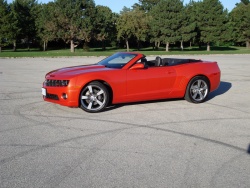 2012 Chevrolet Camaro SS Convertible. Click image to enlarge |
| Related Posts: Test Drive: 2012 Dodge Challenger SRT8 392 First Drive: 2013 Ford Mustang Boss 302 Test Drive: 2013 Mercedes-Benz SLK 55 AMG One From the Vault: Made In Canada – Camaro vs Challenger Manufacturer’s website |
Review and photos by Mike Schlee
Photo Gallery:
2012 Chevrolet Camaro SS convertible
It was five days into my review period with the 2012 Chevrolet Camaro SS Convertible and I was feeling very conflicted about the car. There was a lot to like about this beast, but a lot to not like as well. I was torn as to whether the Camaro’s persona was more akin to a young, charming, in-your-face bad-boy delinquent, or a sad, middle-aged man desperately trying to hold on to the glory days as the star of the local high school football team. I pondered this a bit deeper on a drive home one night from downtown Toronto. It was a very warm summer night and I had the top down, radio on, and V8 engaged. The blue-LED-lit arches in both doors produced a cool glow that reflected the bright lights of the big city as I passed them by on a raised highway. I felt like I was driving in a movie; the ‘cool guy’ leaving the city after a night spent most likely getting up to no good. I began to fully understand this car. The Camaro is an energy rush; it’s testosterone on wheels—the Camaro is automotive Rock n’ Roll.
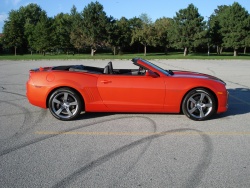 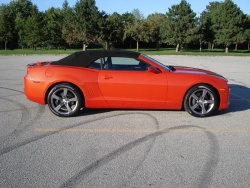 2012 Chevrolet Camaro SS Convertible. Click image to enlarge |
The Camaro SS Convertible is also very heavy: heavy looks, heavy weight, heavy doors, heavy clutch, heavy steering, and, of course, heavy on power. As with the Camaro SS Coupe, the SS Convertible receives one of two 6.2L V8 engines, depending on the transmission choice. Opt for the six-speed automatic and the L99 engine is served up producing 400 hp and 410 lb-ft of torque. However, select the more engaging Tremec TR6060 six-speed manual transmission and the meatier 6.2L LS3 V8 is stuffed into the engine bay where it produces 426 hp and 420 lb-ft of torque. Both engines prefer premium fuel, but do not require it.
I think it took one crank of the engine for me to fall in love with the sound of this V8. The LS3 rumbles no matter what speed the Camaro is going and soon, I found myself looking for long overpasses to really let the engine wail. Leave it in gear as you slow down for a stop sign or red light and the exhaust will delight you with crackles and pops. Could I buy a car on sound alone? This one I might, but I do wish it was louder. With the top down the noise gets washed away into the sea of road noises and I found it actually sounded better with the top up. If I owned this brute, a quick trip to a local exhaust shop would fix this in quick order.
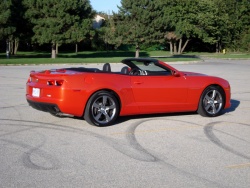 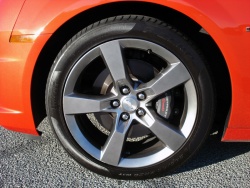 2012 Chevrolet Camaro SS Convertible. Click image to enlarge |
The Camaro is the third muscle car I have driven this summer and is the third vehicle with gearing set too tall. I get the idea of improved fuel consumption, but these are muscle cars that should have a ton of straight-line acceleration. Although the Camaro has a 3.45 final drive gear, the individual gears are tall and take away some of the straight-line performance. In sixth gear, the car lofts along at 100 km/h @ 1,500 rpm, 120 km/h @ 1,750 rpm. The car doesn’t feel all that powerful unless you are hard on the gas and in the higher rpm range; a counterintuitive power delivery method for a pushrod engine, but this one does have variable valve timing. Don’t get me wrong though, the V8 does produce low-end torque and can move the Camaro with authority, but the gearing is so tall that it takes a lot of hooning, noise, and drama to get this heavyweight moving. No muscle car should slightly chirp a tire when making a right hand turn at an intersection under full throttle in first gear, as the Camaro SS Convertible does; there should be an eruption of tire smoke and tail wagging.
Part of the reason the tires will not break loose can be attributed to the sticky, wide rubber that is part of the Camaro SS package. All SS Camaros roll off the factory floor wearing 20-inch wheels with summer tires measuring 245/45ZR20 up front and 275/40ZR20 in the back. Combined with the fully independent suspension, the Camaro handles very well for a vehicle weighing 1,867 kg. The car is prone to understeer, like every new car on the road, but the massive front and rear tires glue themselves to the pavement and compensate for not-completely-perfect suspension setup. The other benefit of the independent rear suspension is that the Camaro does not get upset over railway crossings or frost heaved roads the way the Mustang still can thanks to the solid rear axle (although Ford has been able to tune most of this trait out of the ‘Stang).











